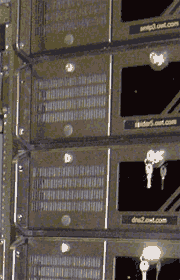Distributed Computing / Grid Computing
Definition: This is a method of computing – the terms Distributed
and Grid are used in very similar ways – which involves the use of many
computers to tackle a computing task together.
These computers may be in different rooms, different buildings, different
countries or different continents. They’re tied together by the software – an
agent – that’s run on them to perform their part of that task.
| |
|

|
Only certain types of task lend themselves to the distributed/grid computing
method, as they need to be divisible into sub-tasks that can be carried out in
parallel, before having their results recombined. A control program accepts the
results of the sub-tasks as they come in from all the computers in the grid and
integrates them to advance the task towards its overall goal.
SETI at Home
The best known public distributed/grid computing project is probably SETI at
Home. The Search for Extra Terrestrial Intelligence involves a massive computing
effort in scanning the results from several different radio telescopes, which
are sweeping the heavens looking for radio signals which can’t easily be
classified as coming from natural sources. If they’re not natural, the argument
goes, they must be coming from a source of intelligent life somewhere else in
the universe.
Using a distributed/grid computing program the immense computing power needed to
analyse all this radio telescope data doesn’t have to be concentrated in one
supercomputer. Instead, it relies on the voluntary donation of computing time by
thousands, if not millions, of interested members of the public. By running a
special screen saver, packets of data are analysed when a volunteer’s PC is
lying idle – rather than popping a copy of the Windows logo round the screen,
these PCs spend their off-duty moments analysing yet another signal packet.
Using this model, SETI at Home and, more recently, projects like the World
Community Grid, have harnessed huge arrays of PCs in grids to tackle problems
like the way proteomes – proteins coded by human gene sequences – fold. The
intention is to make this information freely available to help in the
development of new treatments for disease.
Software
More and more companies are developing software to handle distributed/grid
computing, for both enterprise and public computing projects. One of the leading
suppliers for public projects is United Devices. This software controls both the
SETI and Proteome Folding projects and has been adopted by IBM as part of its
grid computing offering.
|
